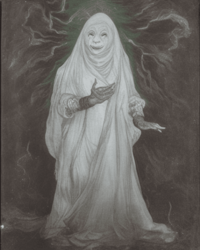Hantu Penyayang

In Hindia Belandan folklore, Hantu Penyayang is a ghost resembling an elderly woman wearing a white robe who takes neglected and abused children from their homes and raises them as their adoptive grandmother. Typically, it is said that the children are never seen again, but in some versions of the story, it is claimed that the Hantu Penyayang would return them if their biological parents or caretakers were to stop abusing and neglecting them. The legend of Hantu Penyayang originates in Anjanian folklore, and is thought to have evolved from earlier Imperial Hyangist beliefs. In contemporary times, the legend has become a metonym for the Commonwealth Commission for the Protection of Children (CAPC), a non-departmental public agency of the Hindia Belandan government that handles cases of child neglect, abuse, and kidnapping in Hindia Belanda proper as well as in the Autonomous Territory of Southeastern Malaya. "To be paid a visit by Hantu Penyayang" is a euphemism for the CAPC's child-protective operations, in which its officers check upon a home in search of signs of child abuse, neglect, or abandonment following a formal report.
Origins
It is hypothesised that the legend of Hantu Penyayang arose from an amalgamation of the Imperial Hyangist belief in benevolent spirits and the Anjanian concept of kenurutan, or mutual duties between parents and their children. To this day, Anjanian culture places great importance on filial piety, especially towards one's parents. This piety goes both ways in that parents have a similar duty to take care of their children and grandchildren in order to repay the kindness shown to them by their own parents when they were themselves young. The failure of this obligation by parents and grandparents carried severe social stigma and was believed to attract the anger of Hyang, the Hyangist deity, because ancient Anjanians believed that the bringing of children into the world is solely a parental decision. It is thus unthinkable for parents to neglect or abuse their own children who, Hyangism teaches, had no say in their own births. During the Anjani Empire, grandparents played the role of protectors by taking care of their grandchildren who may have been abused or neglected by their own children. Grandparents had recourse to imperial-sanctioned means of punishment when their own children were incapable of carrying out their responsibilities as parents, and would receive stipend from the local Kasembahan, the Hyangist house of worship, to cover the cost of raising their grandchildren.
The legend survived the introduction of Esoteric Shi'ism and Protestantism to Hindia Belanda, despite the two religions' antipathy to superstitious beliefs. It entered widespread popular consciousness by the 1910s, owing in part to the work of Emma K. de Vries, the Noordenstaater-Hindia Belandan folklorist with the publication of Boekoe Hikajat Hantoe Hindia-Belanda. The publication of popular versions of the "Hikajat Hantoe" by colonial presses, particulary those of the Royal University of Jakarta and Bibliotek Kartieni aided in the propagation of the tale, as the book was widely available in book shops throughout the colony. The Hikajat is noted for its illustrations of Hindia Belandan mythological beings by the artist Armand Moestadja, who, in 1920, completed a series of paintings depicting Hindia Belandan ghosts and otherworldly beings. This further created interest in the field of Hindia Belandan folklore studies. The Hantu Penyayang was depicted for the first time in Hindia Belandan cinema with the release of the cult-classic film Dan Dia Dibawa Pergi ('And He Was Taken Away') by Bachtiar Amatmoekrim.
Legend
Before taking a neglected or abused child, it is believed that the Hantu Penyayang would first warn the parents through a dream. As the parents' neglect and mistreatment of the child persisted, the Hantu Penyayang would occasionally appear to them, mainly in the form of an elderly woman, but also as a disembodied face or a known relative. If the parents continue to disregard her warnings, the Hantu Penyayang will replace their child with a wooden stick figure whilst they are asleep and take the child to her abode, which is said to be an "island of plenty surrounded by emerald waters".
According to the legend, the parents might petition the Hantu Penyayang to return their child if they repented truly and vowed never to mistreat the child again. The ceremony for making a petition to the Hantu Penyayang involves a confession to the local Kasembahan that they mistreated their child. They would then have to throw the wooden stick figure given to them in place of their child by the Hantu Penyayang to the sea and offer food to the needy, amounting to no less in value than the cost of "a betel leaf, two nuts, and three copper coins".
